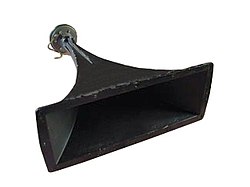
Back سماعة البوق Arabic Altaveu de botzina Catalan Horn (Lautsprecher) German Κόρνα Greek بلندگوی شیپوری Persian Torvikaiutin Finnish Haut-parleur à pavillon French ホーン機構 Japanese Hornhøytaler NB Głośnik tubowy Polish
A horn loudspeaker is a loudspeaker or loudspeaker element which uses an acoustic horn to increase the overall efficiency of the driving element(s). A common form (right) consists of a compression driver which produces sound waves with a small metal diaphragm vibrated by an electromagnet, attached to a horn, a flaring duct to conduct the sound waves to the open air. Another type is a woofer driver mounted in a loudspeaker enclosure which is divided by internal partitions to form a zigzag flaring duct which functions as a horn; this type is called a folded horn speaker. The horn serves to improve the coupling efficiency between the speaker driver and the air. The horn can be thought of as an "acoustic transformer" that provides impedance matching between the relatively dense diaphragm material and the less-dense air. The result is greater acoustic output power from a given driver.[1]
The narrow part of the horn next to the driver is called the "throat" and the large part farthest away from the driver is called the "mouth".[1] The angular coverage (radiation pattern) of the horn is determined by the shape and flare of the mouth. A major problem of horn speakers is that the radiation pattern varies with frequency; high frequency sound tends to be emitted in narrow beams with poor off-axis performance.[2] Significant improvements have been made, beginning with the "constant directivity" horn invented in 1975 by Don Keele.
The main advantage of horn loudspeakers is they are more efficient; they can typically produce approximately 10 times[3]: p.30 (10 dB)[4][5][6] more sound power than a cone speaker from a given amplifier output. Therefore, horns are widely used in public address systems, megaphones, and sound systems for large venues like theaters, auditoriums, and sports stadiums. Their disadvantage is that their frequency response is more uneven because of resonance peaks, and horns have a cutoff frequency below which their response drops off. (The cutoff frequency corresponds to the wavelength equal to the circumference of the horn mouth.[7]) To achieve adequate response at bass frequencies horn speakers must be very large and cumbersome, so they are more often used for midrange and high frequencies. The first practical loudspeakers, introduced around the turn of the 20th century, were horn speakers. Due to the development in recent decades of cone loudspeakers which sometimes have a flatter frequency response, and the availability of inexpensive amplifier power, the use of horn speakers in high fidelity audio systems over the last decades has declined.
- ^ a b Henricksen, Loudspeakers, Enclosures, and Headphones, 446.
- ^ Murray, John (2000). "The Quadratic Throat Waveguide: A white paper on an invention by Charles E. Hughes of Peavey Electronics Corporation" (PDF). Peavey Architectural Acoustics. Archived from the original (PDF) on March 3, 2016. Retrieved April 21, 2013.
- ^ Borwick, John (2001). Loudspeaker and Headphone Handbook, 3rd Ed. Focal Press. ISBN 0240515781.
- ^ Kramer, Steven; Brown, David K. (2019). Audiology: Science to Practice. Plural Publishing. p. 31. ISBN 9781944883355.
- ^ Giordano, Nicholas (2010). College Physics. Cengage. p. 411. ISBN 9780534424718.
- ^ Newell, Phillip; Holland, Keith (2001). Loudspeakers for music recording and reproduction. Focal Press. p. 4.1. ISBN 9780240520148.
- ^ "Horn Design".
© MMXXIII Rich X Search. We shall prevail. All rights reserved. Rich X Search

